
Mariotto di Bindo di Biagio Albertinelli was an Italian Renaissance painter active in Florence. He was a close friend and collaborator of Fra Bartolomeo.

The Uffizi Gallery is a prominent art museum located adjacent to the Piazza della Signoria in the Historic Centre of Florence in the region of Tuscany, Italy. One of the most important Italian museums and the most visited, it is also one of the largest and best-known in the world and holds a collection of priceless works, particularly from the period of the Italian Renaissance.

Filippino Lippi was an Italian painter working in Florence, Italy during the later years of the Early Renaissance and first few years of the High Renaissance.

Domenico Veneziano was an Italian painter of the early Renaissance, active mostly in Perugia and Tuscany.
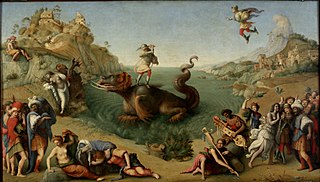
Piero di Cosimo, also known as Piero di Lorenzo, was an Italian painter of the Renaissance.

Filippo Lippi, also known as Lippo Lippi, was an Italian painter of the Quattrocento and a Carmelite priest. He was an early Renaissance master of a painting workshop, who taught many painters. Sandro Botticelli and Francesco di Pesello were among his most distinguished pupils. His son, Filippino Lippi, also studied under him and assisted in some late works.

The Palazzo Pitti, in English sometimes called the Pitti Palace, is a vast, mainly Renaissance, palace in Florence, Italy. It is situated on the south side of the River Arno, a short distance from the Ponte Vecchio. The core of the present palazzo dates from 1458 and was originally the town residence of Luca Pitti, an ambitious Florentine banker.

The Palazzo Medici, also called the Palazzo Medici Riccardi after the later family that acquired and expanded it, is a Renaissance palace located in Florence, Italy. It is the seat of the Metropolitan City of Florence and a museum.
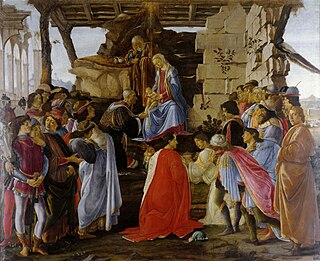
The Adoration of the Magi is a painting by the Italian Renaissance master Sandro Botticelli. Botticelli painted this piece for the altar in Gaspare di Zanobi del Lama's chapel in Santa Maria Novella around 1475. This painting depicts the Biblical story of the Three Magi following a star to find the newborn Jesus. The image of the altarpiece centers on the Virgin Mary and the newborn Jesus, with Saint Joseph behind them. Before them are the three kings who are described in the New Testament story of the Adoration of the Magi. The three kings worship the Christ Child and present him with gifts of gold, frankincense and myrrh. In addition, the Holy Family is surrounded by a group of people who came to see the child who was said to be the son of God.

The Magi Chapel is a chapel in the Palazzo Medici Riccardi of Florence, Italy. Its walls are almost entirely covered by a famous cycle of frescoes by the Renaissance master Benozzo Gozzoli, painted around 1459 for the Medici family, the effective rulers of Florence.
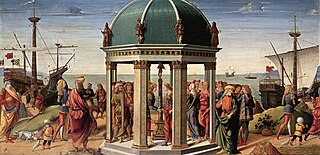
Biagio d’Antonio Tucci was an Italian Renaissance painter active in Florence, Faenza and Rome.

Seven Saints is a tempera on panel painting by the Italian Renaissance master Filippo Lippi, dating to c. 1449–1459, in the collection of the National Gallery, London. It is a pendant to Lippi's Annunciation, also in the National Gallery. The lunettes were commissioned as part of the decoration of the Palazzo Medici in Florence, where they were likely placed above a door or a bed.

The Annunciation is a tempera on panel painting by the Italian Renaissance master Filippo Lippi, dating to c. 1449–1459, in the collection of the National Gallery, London. It is a pendant to Lippi's Seven Saints, also in the National Gallery. The lunettes were commissioned as part of the decoration of the Palazzo Medici in Florence, where they were likely placed above a door or a bed.

The Lamentation of Christ is an oil-on-panel painting of the common subject of the Lamentation of Christ by the Netherlandish artist Rogier van der Weyden, dating from around 1460–1463 and now in the Uffizi Gallery, Florence, Italy.
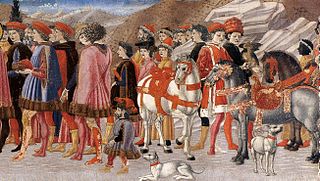
Giovanni di Francesco del Cervelliera or Giovanni di Francesco was an Italian Renaissance painter, active in Florence in the mid-fifteenth century.
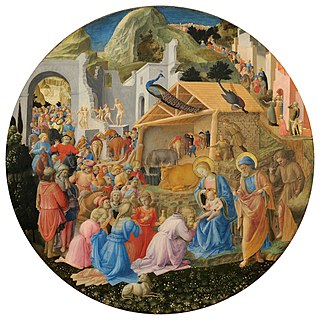
The Adoration of the Magi is a tondo, or circular painting, of the Adoration of the Magi assumed to be that recorded in 1492 in the Palazzo Medici Riccardi in Florence as by Fra Angelico. It dates from the mid-15th century and is now in the National Gallery of Art in Washington D.C. Most art historians think that Filippo Lippi painted more of the original work, and that it was added to some years after by other artists, as well as including work by assistants in the workshops of both the original masters. It has been known as the Washington Tondo and Cook Tondo after Herbert Cook, and this latter name in particular continues to be used over 50 years after the painting left the Cook collection.

The Medici Villa of Poggio a Caiano, also called Ambra, is one of the most famous Medici villas and is located in Poggio a Caiano (Prato). Today it is state owned and it houses two museums: one of the historic apartments and the Museum of Still Life.
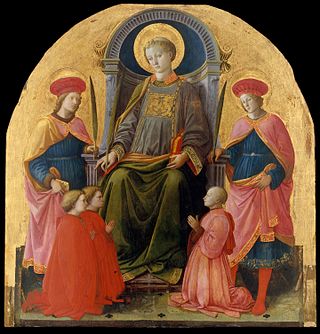
The Alessandri Altarpiece is a tempera on panel painting by Filippo Lippi, also known as Saint Lawrence Enthroned Between Saints Cosmas and Damian and Donors and Saint Lawrence Enthroned with Saints and Donors. It is now in the Metropolitan Museum of Art in New York.

The Novitiate Altarpiece or Madonna and Child with Saints is a c.1440-1445 tempera on panel painting by Filippo Lippi, now in the Uffizi in Florence. A sacra conversazione, it originally had a predella painted by Pesellino centred on a Nativity. The main panel shows Cosmas and Damian either side of the Madonna and Child, whilst Francis of Assisi is shown at far left and Anthony of Padua at far right. On an architectural frieze above the figures are the Medici's heraldic balls.

The Pagagnotti Triptych is an oil-on-wood triptych by Hans Memling produced circa 1480. The original was disassembled and separated, with the center panel held at the Uffizi gallery in Florence and the two wing panels at the National Gallery in London.




















